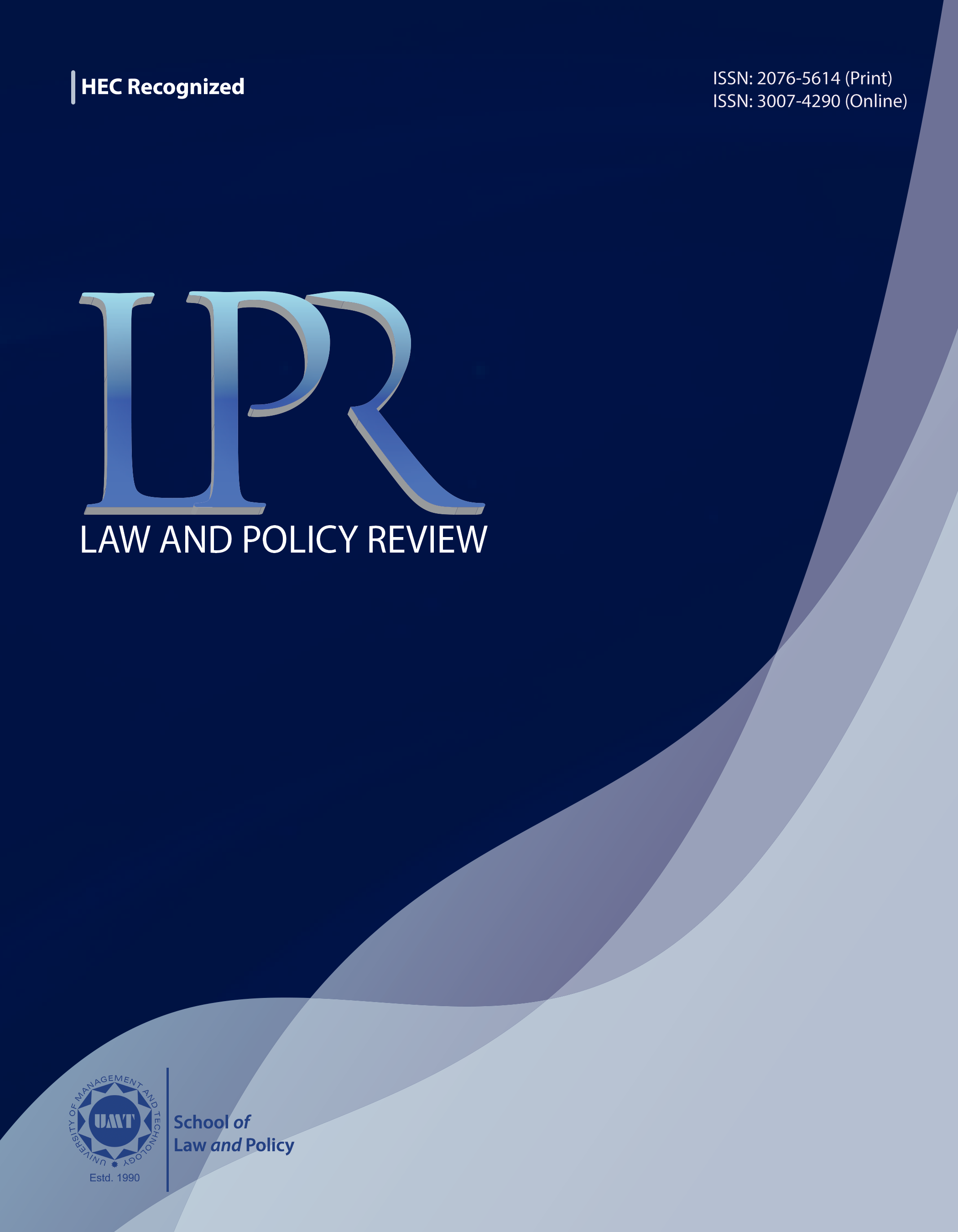Theory of Reverse Discrimination and its Operationalization in the Legal System of Pakistan
Abstract
 Abstract Views: 0
Abstract Views: 0
This research paper aims to exhaustively explore and elaborate the doctrine of reverse discrimination in the context of the legal system of Pakistan. It begins by examining the historical background of the concept through the contours of American jurisprudence that defined it whilst also exploring the dimensions of various English traditions of ethical philosophy that served as the conceptual cornerstone of the theory of reverse discrimination. This paper deploys comparative and doctrinal research methodologies to critically examine the implication of reverse discrimination in the legal strata of Pakistan. Following such definitional examination, it proceeds to analyze the position of this concept in the former and current constitutional frameworks of Pakistan. It argues that reverse discrimination is a viable solution to curb structural discrimination and inequality existing in the society, with reference to judgments tendered by the Supreme Court of Pakistan. Furthermore, this paper assesses penal statutes namely the Juvenile Justice System Act 2018 and Protection against Harassment of Women at the Workplace Act 2010 enacted pursuant to the goal of operationalizing the theory of reverse discrimination in the legal framework of Pakistan and in doing so shall examine the policy and statutory praxis of the doctrine in Pakistan. Lastly, it discusses the implications and consequences of deployment of reverse discrimination doctrine and affirmative action-based policy.
Downloads
References
Abdul Fareed v. N.E.D. University of Engineering and Technology, CLC 347 (2001). https://sys.lhc.gov.pk/appjudgments/2019LHC880.pdf
Banoo, S. (2020). The sexual harassment of women at workplace (prevention, prohibition and redressal) Act, 2013- Legislative commentary. Social Science Research Network, Article e3697540 https://doi.org/10.2139/ssrn.3697540
Bibi, T. (2015). Article 25th A: Implications of free and compulsory secondary education. VFAST Transactions on Education and Social Sciences, 6(1), 57–63.
Blackstone, W. T. (1975). Reverse discrimination and compensatory justice. Social Theory and Practice, 3(3), 253–288.
Carlson, C. Y. H. (2018). Meritocracy or quota system will benefit admission to public universities. https://www.academia.edu/35857579/Meritocracy_or_Quota_System_Will_Benefit_Admission_to_Public_Universities
Chowdhury, M., & Ghosh, S. (2011). Constitutional governance and rule of Law. Social Science Research Network, Article e1956317. https://doi.org/10.2139/ssrn.1956317
Crosby, F. J., Iyer, A., & Sincharoen, S. (2006). Understanding affirmative action. Annual Review of Psychology, 57(1), 585-611. https://doi.org/10.1146/annurev.psych.57.102904.190029
Defunis v. Odegaard, 94 S. Ct. 1704 (1974). https://www.casebriefs.com/blog/law/constitutional-law/constitutional-law-keyed-to-cohen/the-jurisdiction-of-federal-courts-in-constitutional-cases/defunis-v-odegaard/
Desai, A. C. (2022). Is title VII an “Anti-Discrimination” law? University of Colorado Review, 93, 1–10.
Dr. Shahnawaz Wajid v. Federation of Pakistan, PLC (C.S.) 1052 (2012). https://advocategeneral.punjab.gov.pk/system/files/affirmative%20action%20(1).pdf
Dworkin, R. (1977). Taking rights seriously. Harvard University Press.
Ellahi Cotton Mills Limited vs. Federation of Pakistan through Secretary M/O Finance, Islamabad and 6 others, PLD 582 (1997).
Ferraro, F. (2010). Direct and indirect utilitarianism in Bentham’s theory of adjudication. Journal of Bentham Studies, 12(1), 1–24. https://doi.org/10.14324/111.2045-757x.038
Galchus, K. (1981). Affirmative action and reverse discrimination: Where do we stand now. University of Arkansas at Little Rock Law Review, 4(2), Article e3.
I.A. Sherwani v. Government of Pakistan, SCMR 1041 (1991).
Khawar Kayani v. The State, Crl.P No. 345/2022 (2022).
Krook, M. L. (2009). Quotas for women in politics: Gender and candidate selection reform worldwide. Oxford University Press.
Kumm, M. (2010). The idea of socratic contestation and the right to justification: The point of rights-based proportionality review. Law & Ethics of Human Rights, 4(2), 142–175. https://doi.org/10.2202/1938-2545.1047
Moreau, S. (2010). What is discrimination? Philosophy & Public Affairs, 38(2), 143–179. https://doi.org/10.1111/j.1088-4963.2010.01181.x
Mst. Attiyya Bibi Khan and others v. Federation of Pakistan, SCMR 1161 (2001)
Mushtaq, A. (2014). Constitutional and legal rights of women in Pakistan. Women Aid Trust. https://tinyurl.com/4et3vwt9
Naseem Firdous v. Punjab Small Industries Corporation, PLD Lahore 584 (1995). https://advocategeneral.punjab.gov.pk/system/files/affirmative%20action%20(1).pdf
Pattaro, E. (2006). A treatise of legal philosophy and general jurisprudence. Ratio Juris, 19(4), 489–500. https://doi.org/10.1111/j.1467-9337.2006.00341.x
Rakshita, P. (2020). Application of principles of natural justice to administrative actions. Social Science Research Network, Article e3622103. https://doi.org/10.2139/ssrn.3622103
Reviglio, P. (2015). Affirmative action in Higher education policies: development and evidence from modern India. https://www.academia.edu/14459553/Affirmative_action_in_Higher_education_policies_development_and_evidence_from_modern_India
Riaz, S. (2010). Implementation mechanism: Protection against harassment of women at workplace Act 2010. Social Science Research Network, Article e1713087. https://doi.org/10.2139/ssrn.1713087
Saleh, N. (2017). Revisiting quota system in civil service of Pakistan. In A. Farazmand (Ed.), Global encyclopedia of public administration, public policy, and governance (pp. 1–4). Springer. https://doi.org/10.1007/978-3-319-31816-5_3487-1
Schiavo-Campo, S. (2001). To serve and to preserve: Improving public administration in a competitive world. Asian Development Bank Institute.
Smith, R. (2013). “To see themselves as others see them”: The five permanent members of the security council and the human rights council’s universal periodic review. Human Rights Quarterly, 35(1), 1–32.
Sweatt v. Painter, 339 U.S. 629, 70 S. Ct. 848 (1945). https://www.law.cornell.edu/supremecourt/text/339/629
Taimur, M. (2016, April 17). Implementing JJSO. DAWN. https://www.dawn.com/news/1252503
Temirbekov, Z. (2021). Albert Venn Dicey and the rule of law. Law And State, 1, 6–14. https://doi.org/10.51634/2307-5201_2021_1_6
United Nations (1989, November 20). Convention on the rights of the child. https://www.ohchr.org/en/instruments-mechanisms/instruments/convention-rights-child
Uzma Naveed Chaudhary & others v. Federation of Pakistan, CP No. 1347 & 1655 (2019). https://lrc.shc.gov.pk/downloads/august2022.pdf
Wexler, S., & Irvine, A. D. (2006). Aristotle on the rule of law. Polis: The Journal for Ancient Greek Political Thought, 23(1), 116–138. https://doi.org/10.1163/20512996-90000089
Copyright (c) 2024 Syed Shaharyar Ahmed, Mian Johar Imam, Muhammad Sheharyar Iftikhar

This work is licensed under a Creative Commons Attribution 4.0 International License.
LPR follow an open-access publishing policy and full text of all published articles is available free, immediately upon publication of an issue. The journal’s contents are published and distributed under the terms of the Creative Commons Attribution 4.0 International (CC-BY 4.0) license. Thus, the work submitted to the journal implies that it is original, unpublished work of the authors (neither published previously nor accepted/under consideration for publication elsewhere). On acceptance of a manuscript for publication, a corresponding author on the behalf of all co-authors of the manuscript will sign and submit a completed the Copyright and Author Consent Form.





